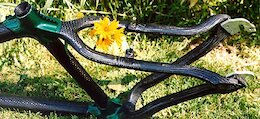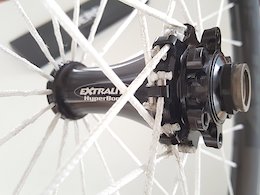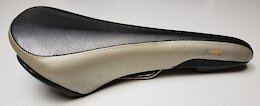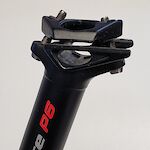R-M-R
- Member since Dec 15, 2009 Online
-
 Calgary , Alberta
Calgary , Alberta - 128 Followers
- 13 Trailforks Points
Recent

R-M-R Mandownmedia's article
May 8, 2024 at 10:59
14 hours
Spotted: Privateer Bikes Prototype Downhill Bike
With so many World Cup riders adding lead weights, maybe a hefty DH frame isn't a bug, it's a feature.

R-M-R Mandownmedia's article
May 8, 2024 at 10:54
15 hours
Spotted: Privateer Bikes Prototype Downhill Bike
More of a YT guy?

R-M-R dariodigiulio's article
May 8, 2024 at 3:43
22 hours
First Look: The Rotwild R.EXC is a Race-Focused eMTB With a 820 Wh Battery
@thekaiser: Two ways to look at it:
First, the height of the pivot - and we have to look at the instant centre, i.e. the "virtual pivot", which could be located anywhere, regardless of the physical location of the linkage. Something that looks similar to the Bianchi Super G you mentioned could have a very low instant centre, and vice versa.
Second, we could ignore the hardware and the even the instant centre, instead considering what it actually does, i.e. consider the pedaling anti-squat, brake squat, axle path, etc. without getting bogged down in discussions of what hardware produces the properties we feel when we ride.
I favour the latter, which removes any need to discuss the height of the pivot(s) (or the instant centre). The more we look at pivot height, the more problematic it becomes. If we're considering the instant centre location, we need to standardize the sprocket combination and the point in the travel, as some designs vary the IC location greatly throughout the travel and/or produce dramatically different kinematics across the cassette range. If we're considering the physical hardware, it becomes clear how problematic this approach can be when a SS (short & short) linkage can have an infinitely high instant centre with both links located under the BB.
Unless someone has a more robust and universal solution, I can only propose we note the presence or absence of indirect drive mechanisms and discuss each kinematic property (ex. pedaling anti-squat, brake squat, axle path, pedal kickback, etc.) as low / mid / high according to how they compare to typical values. Doing so, we can observe relationships between kickback, anti-squat, and axle path that indicate whether a design warrants an indirect drive. We might also see how some designs manage to maintain high values of some (arguably) favourable properties without incurring enough kickback to warrant an idler, while others may incur the drag and hassle of an idler without taking full advantage of the flexibility it offers. I believe viewing designs in terms of what they do facilitates a deeper understanding of how the design translates to the ride experience, and the ability to quantify and critique aspects of the design.

R-M-R dariodigiulio's article
May 7, 2024 at 20:26
1 day
First Look: The Rotwild R.EXC is a Race-Focused eMTB With a 820 Wh Battery
@cedric-eveleigh: No one likes changes to the familiar, whether that's terminology, BB standards, or derailleurs, but I thought you - of all people - might appreciate overcoming the hurdle of change to arrive at a more fit-for-purpose alternative. ;)

R-M-R dariodigiulio's article
May 7, 2024 at 20:16
1 day
First Look: The Rotwild R.EXC is a Race-Focused eMTB With a 820 Wh Battery
@cedric-eveleigh: Perhaps I can reframe my point: The problem is not with "high" and "low" as adjectives to describe pivot locations, but "high pivot" as the classification for all indirect drive designs and "low pivot" to describe all direct drive designs.

R-M-R dariodigiulio's article
May 7, 2024 at 20:06
1 day
First Look: The Rotwild R.EXC is a Race-Focused eMTB With a 820 Wh Battery
@cedric-eveleigh: I understand your point, but it's not the best way to group together similar properties, and it uses a term that can be incorrect.
If a bike without an idler can have a higher instant centre than a bike with an idler, why use the term "high pivot" to describe the one with the lower pivot? Why not just call them what they are - direct and indirect - then discuss the pedaling anti-squat, axle path, etc. as needed?
If nothing else, it avoids the silliness of talking about "high low-pivots" and "low high-pivots". Just mention whether there's an idler, then move on to the actual kinematics.

R-M-R dariodigiulio's article
May 7, 2024 at 19:49
1 day
First Look: The Rotwild R.EXC is a Race-Focused eMTB With a 820 Wh Battery
@cedric-eveleigh: Exactly: What [I]is[/I] the threshold? If the presence or absence of an idler doesn't produce a common set of properties, we should use properties and terms that more accurately group designs with common ride characteristics.
First, an examples of this problem is the common belief that LS 4-bar (long & short link, such as Horst) designs are "plush", but don't pedal as crisply as SS (short & short, such as VPP, dw, Maestro, etc.). This originated from early uses of the LS configuration often placing the pivot on the BB shell, while single-pivot designs often preferred to use a high pivot and elevated chainstays. Fast forward to the present and the bikes with the highest pedaling anti-squat values in recent history are a mix of single-pivots, LS, and SS, and the lowest values are a mix of LS and SS. There never was an intrinsic relationship between the configuration and the pedaling characteristics, which has finally become apparent to most people.
The point of that analogy is that "high pivot" bikes also have a wide range of values for pedaling anti-squat, brake squat, motion ratio curves, axle paths, etc. Current "high pivot" designs have the highest anti-squat I've found in the past 1.5 decades (Insanity of Gravity UHP-FR V2) and tied for the lowest (Starling Sturn 29 V2). Even the axle paths have some - not much, but not zero - overlap with direct drive designs. This is why I don't recommend simply lumping all such designs together under the "high pivot" term and implying they're all similar to one another and completely distinct from direct drive designs. Instead, I recommend distinguishing direct vs. indirect and making some sort of effort to quantify or qualify the relevant kinematic properties.
For example, we could talk about the UHP-FR V2 having an indirect drive with extremely rearward axle path and extremely high pedaling anti-squat, while the Sturn 29 V2 has an indirect drive with moderately rearward axle path and extremely low pedaling anti-squat. It's not as concise as simply calling them both "high pivot" designs, but being concise is of little value when it's incomplete at best, and misleading at worst.
Finally, to address the statement: "Any bike without an idler pulley should not be called a high pivot bike because it'll never have a pivot nearly as high as typical high pivot bikes." This is not so, as I demonstrated in my previous message. There isn't much overlap between direct and indirect designs, but there's a little overlap and the two groups certainly abut one another. I say that not to be nit-picky, but to refute the notion that the instant centres of direct drivetrains can never be nearly as high (without wading into the murky definition of whether a low-high-pivot counts as a "typical" high pivot).

R-M-R dariodigiulio's article
May 7, 2024 at 16:12
1 day
First Look: The Rotwild R.EXC is a Race-Focused eMTB With a 820 Wh Battery
@cedric-eveleigh: I was thinking about the bad old days of sometimes absurd kinematics, which is why I used the past tense "there have been". It's an interesting question whether that holds true for any current models. I'd have to test it by removing the idler from a couple hundred simulations, which I'm sure you'll understand if I don't do, but I'll do a quick test.
The highest anti-squat values I can think of (values taken at 33% compression, zero pitch, size M, my standard centre of mass location for size M) with direct drivetrains are the Ghost Riot TR and Terrain Control Crowbar. The lowest indirect systems that come immediately to mind are the new YT Tues prototype and the Mondraker Summum from 2022. These aren't production bikes, of course, but they're recent/current and have been described as "high pivot" designs due to the presence of idlers.
My simulations show the YT and Mondraker without their idlers have lower ICs at the aforementioned conditions than the Ghost and Terrain Control. There may be additional examples with more widely available models.

R-M-R dariodigiulio's article
May 7, 2024 at 13:37
1 day
First Look: The Rotwild R.EXC is a Race-Focused eMTB With a 820 Wh Battery
That's why I prefer to use the terms "direct drive" and "indirect drive" to distinguish. As you know, there have been bikes with idlers that have a lower instant-centre than others without an idler, so the terms "high pivot" and "low pivot" are ambiguous at best and simply incorrect at worst.
Also, the claim that anti-rise over an arbitrary value leads to "the dreaded brake jack" is both nonsense (there is no significant change that occurs at this value) and wrong ([I]low[/I] anti-rise leads to brake jack - the meaning of the words should've been their first clue!). High anti-squat can lead to reduced traction when braking, but a mistake like indicates either their kinematics designer or marketing copy writer has no clue what they're talking about - let's hope it's the latter.

R-M-R mikekazimer's article
May 3, 2024 at 14:22
May 3, 2024
Pinkbike Poll: Hip Pack, Vest, or Backpack?
@dcaf: Sounded crazy to me, too, but now that I think about it, I carry a chainbreaker and spare link without any chain failures in years, yet I've snapped two cables since my last chain failure.
28,360 views
214 Photos
5 Blog Posts
- Faux-bar or four-bar? Jun 13, 2023 – Comments: 12
- Damping Curves - Digressive, Linear, Progressive Feb 15, 2021 – Comments: 4
- Slideway lubricant as bath oil Feb 2, 2021 – Comments: 9
- How much does mass matter - Hubs Feb 1, 2021 – Comments: 7
- Insight into chainless WC DH runs Jan 13, 2021 – Comments: 10








